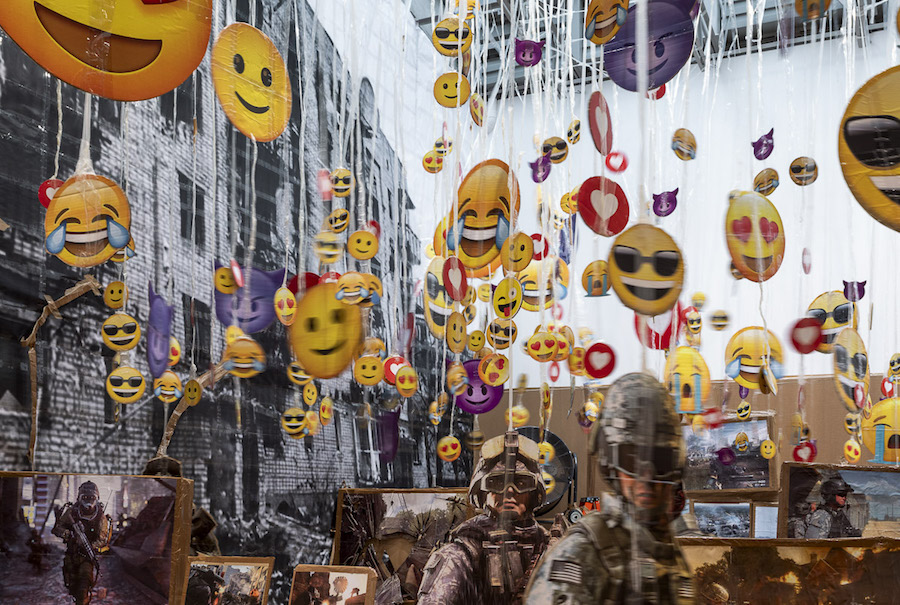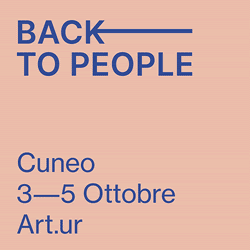
English version below
Testo di Luciana Fabbri —
In questi giorni siamo costantemente inondati da immagini di violenza, che ci invadono all’interno delle nostre case tramite i computer, i cellulari e la televisione. Ma che tipo di arte dovrebbe essere fatta in momenti di oscurità e disperazione? Come poter continuare a fare arte in tempi di guerra, distruzione, rabbia, odio e risentimento?
Queste sono le domande introduttive che Thomas Hirschhorn solleva nella mostra Fake it, Fake it – till you Fake it, inaugurata il 24 Gennaio alla Gladstone Gallery di New York e in corso fino al 2 marzo.
Nel 1971 l’artista americano Chris Burden durante la celebre performance Shoot si fece sparare da un amico sul braccio con un fucile. Visionario scuotitore della coscienza umana, durante gli anni del conflitto tra gli Stati Uniti e il Vietnam, Burden si interrogava su cosa significasse compiere e testimoniare un atto di violenza. Se colpisci fisicamente qualcuno, puoi vedere le conseguenze sia su quel corpo che dentro di te. Cosa succede quando un’immagine di violenza è mediata? Il processo di mediazione riduce il senso di responsabilità per un atto di violenza?
Entrando nella mostra di Hirschhorn ci si immerge in un ambiente simile ad un ufficio: file di scrivanie, computer con schermi di varie dimensioni, stazioni di ricarica con numerosi iPad o iPhone collegati attraverso cavi visibili. Tutto è realizzato con tre materiali principali: cartone, polistirolo e nastro adesivo. Gli schermi presentano immagini di guerra, di soldati che impugnano armi, esplosioni ed edifici crollati. C’è una sensazione di precarietà e non siamo pienamente consapevoli di ciò che stia accadendo. Si tratta di immagini tratte dalla realtà o basate su simulazioni e giochi?
Sulla parete sinistra vediamo una grande immagine in bianco e nero di un edificio distrutto. Sebbene la maggior parte di queste immagini siano recenti e provengano dai conflitti in Ucraina o a Gaza, l’artista sceglie di presentarci immagini di rovine la cui ubicazione è difficile da identificare, sottolineando come la condivisione di immagini di rovine richiami una certa familiarità con tutte le rovine in generale, includendone anche alcune riprese dall’antichità. L’utilizzo del cartone rende tutto estremamente posticcio, ma allo stesso tempo reale perché è fisico, giocando sull’ambiguità tra realtà e finzione.
Sospesi dal soffitto, e posizionati all’altezza del nostro corpo vediamo delle sagome di soldati avatar. L’artista sceglie di alternare immagini/documento di guerra, insieme ad immagini e figure che provengono da diversi videogiochi, situandosi così nell’intersezione tra ‘reale’ e ‘virtuale’ nel tentativo di simulare la ‘guerra reale’.
Nel 2006, il grande duo fotografico Adam Broomberg e Oliver Chanarin problematizzò come lo stato del ‘reale’ fosse influenzato dalla sua simulazione. Nel loro lavoro intitolato Chicago, riflettendo sulla rappresentazione simbolica e reale di un territorio, presentarono immagini di una città artificiale nel deserto del Negev, costruita dall’esercito israeliano all’inizio degli anni ’80 con l’obiettivo di creare lo scenario di guerra più realistico possibile per addestrare le forze speciali israeliane.

Come riportato dal The New York Times, l’idea che i videogames potrebbero abituare le persone all’idea della guerra è stata ampiamente assodata. Nel 2002, l’esercito americano ha collaborato con alcuni tra i maggiori sviluppatori di videogiochi per creare il suo proprio software First Person Shooter (lo sparatutto in prima persona) e attirare così le giovani reclute. Fu un successo.
Hirschhorn aggiunge un altro livello di analisi. Se oggi l’intelligenza artificiale fornisce ricostruzioni sempre più precise della realtà, ciò che è in gioco non è solo il peso delle immagini, che perdono importanza in quanto documenti, ma la realtà stessa. “Stiamo parlando di intelligenza artificiale, ma perché non parlare anche di volontà artificiale, speranze artificiali, resistenza artificiale, intuizione artificiale, e perché non anche visione artificiale? La visione che solo i nostri occhi possono vedere? Non rinunciare mai alle competenze umane oltre all’intelligenza, per sfuggire al controllo robotico.” Scrive Hirschhorn con la bomboletta di vernice sulla parete della galleria.
Le continue immagini di violenza, hanno l’effetto di neutralizzare piuttosto che risvegliare la nostra empatia? Hirschhorn ricostruisce così la nostra realtà quotidiana: seduti di fronte ai nostri laptop con false carte di credito, sostanze eccitanti come Red Bull, cocaina o sigarette, forse per compensare la perdita di contatto con una realtà che diventa sempre più rarefatta. Una realtà che diventa leggera, come il ventilatore che spinge i diversi volti emoji appesi al soffitto. Le nostre emozioni e la nostra realtà diventano leggere come il polistirolo, banalizzate e svuotate. Ogni azione perde peso, incluso la violenza.
Già nel 1994 in Cattiva maestra televisione il filosofo Karl Popper proponeva l’istituzione di una patente per chi produceva contenuti televisivi. Una provocazione con cui Popper denunciava la televisione in quanto strumento di potere, in grado di manipolare gli individui, stimolandone i consumi, i comportamenti e creando dipendenza. Ma soprattutto producendo individui conformisti e passivi, mettendo quindi a rischio la democrazia.
Scrive Hirschhorn: “Lavorare nel ‘mondo reale’ per il ‘mondo reale’ è il mio obiettivo. Voglio insistere sull’importanza delle decisioni materiali nelle sue dimensioni plastiche. Mi riconosco nella convinzione-cliché della Silicon Valley ‘fingi, finghi finché non ci riesci’, non stiamo forse tutti cercando di fare lo stesso? Anch’io voglio fingere così tanto, così a lungo e lontano, che le cose non mentano più. Perché fingere non è il problema. Mentire è il problema. E io non voglio mentire, non voglio che le cose mentano.””. Attraverso la sua monumentale installazione precaria, Hirschhorn si domanda quale forma artistica possa contrastare l’influenza e la complicità del consumismo digitale e la fittizia pretesa utopica dell’intelligenza artificiale.


“I don’t want to lie” | Thomas Hirschhorn, Gladstone Gallery, New York
Text by Luciana Fabbri —
These days we are constantly flooded by images of violence, that invade us in the comfort of our homes through our laptops, phone and television. But what kind of art should be done in moments of darkness and desperation? How to make art in times of war, destruction, violence, anger, hate, resentment? How to continue working – as an artist – and in doing so, avoid falling into the traps of facts, journalisms and comment?
These are the introductory questions Thomas Hirschhorn raises in the exhibition Fake it, Fake it – till you Fake it, on view at Gladstone Gallery until March 2.
In 1971 American artist Chris Burden performed his famous Shoot piece, having his friend actually shoot him with a gun on his arm. As an electric shaker of human conscience, during the years of the conflict between the US and Vietnam, Burden questioned what it meant to make and witness an act of violence. If you physically punch or hit someone, you can see the consequences both on that body and within your own. What happens to our perceptions when an image of violence is mediated? Does this mediation reduce the sense of responsibility for a violent act?
As you walk into Hirschhorn’s show, you are immersed in an office-like environment: rows of desks, laptops with screens of various dimensions, charging station with multiple iPads or iPhones attached through visible cords. Everything is made out of three main materials: cardboard, styrofoam and tape. All the screens include printed images of ruins, soldiers with guns, explosions and collapsed buildings. There is a strong feeling of precarity and we are not fully conscious of what is happening. Are these images taken from reality or are they game-based simulations?
On the left wall we see a large, black and white image of a destroyed building. Throughout the exhibition, the artist conscientiously presents us with images of ruins whose specific location is difficult to identify. While all of the images are recent and mostly taken in Ukraine or Gaza, Hirschhorn places emphasis that by sharing images of ruins, one recalls a familiarity with all kind of ruins, including some ancient ones as well. The use of cardboard makes everything look extremely fake, but at the same time real because it is physical, playing on the ambiguity between reality and fiction.
These pictures are also interspersed with images from different video games and avatar soldier silhouettes, which are hanging from the ceiling and are placed on our eye level. In these images from war video games, the figures and aesthetic imitate scenarios that appear to be war, lying in the intersection between ‘real’ and ‘virtual’ while attempting to simulate ‘real war.’
Back in 2006, the great photographic duo Adam Broomberg and Oliver Chanarin, questioned how the status of the ‘real’ was affected by its documentation. In their work titled Chicago, reflecting on the symbolic and real representation of a territory, they presented images of an artificial city in the Negev desert, built by the Israeli army in the early 1980s with the aim of creating the most realistic possible scenario for training Israeli special forces.

As reported by The New York Times, the belief that videogames may get people used to the idea of war has already been established. In 2002 the US Army collaborated with major videogame developer to make its own first-person-shooter franchise to attract new potential recruits. And it was a success.
Furthering the question of how our experience of reality is conditioned by its simulation, Hirschhorn adds another level of analysis. If today artificial intelligence provides increasingly precise reconstructions of reality, what is at stake is not only the weight of images as documents, but reality itself and our human capabilities. “We are talking about artificial intelligence, but why not about artificial willpower, artificial hopes, artificial resistance, artificial intuition, and why not also artificial vision? The vision which only our own eyes can see? Never give up human competences other than, intelligence, in order to escape robotic control.”
Today’s incessant flow of violent images has the effect to numb us rather than awake our empathy?
Hirschhorn emphasizes the fragility of our present condition: sitting in front of our laptops with our fake credit cards, bamboozled, addicted to exciting substances like Red Bull, coke or cigarettes, perhaps to compensate for our loss of touch with a reality that becomes increasingly rarefied. A reality becoming light, like the fan that blows the different emoji faces hanging from the ceiling. Our emotions and reality become light as styrofoam, banalized and rendered empty. Every action loses its weight, including violence.
Already in 1994, the Austrian philosopher Karl Popper proposed the establishment of a license for those who worked in television: a provocation through which the philosopher highlighted the risks of television as an instrument of power, capable of manipulating individuals, influencing their behavior and consumption and creating dependency. Above all, Popper spoke of the risk of producing conformist and passive individuals therefore posing a threat to democracy.
“To work in ‘the real world’ for ‘the real world’ is the commitment. I want to insist on the importance of material decision in its plastic dimensions. Silicon valley statement fake it till u make it. I include myself in this cliché-credo, are we not all trying to do so? I too, want to fake it so much so long and far, that things don’t lie anymore. Because fake it’s not the problem. Lying is the problem. And I do not want to lie, I do not want things to lie.” Through his monumental precarious sculpture, Hirschhorn considerswhat artistic form can counter the influence and complicity of digital consumerism and the utopian claim of artificial intelligence.
Thomas Hirschhorn: “Fake it, Fake it – till you Fake it.”
January 24 – March 2, 2024
Gladstone Gallery, New York









